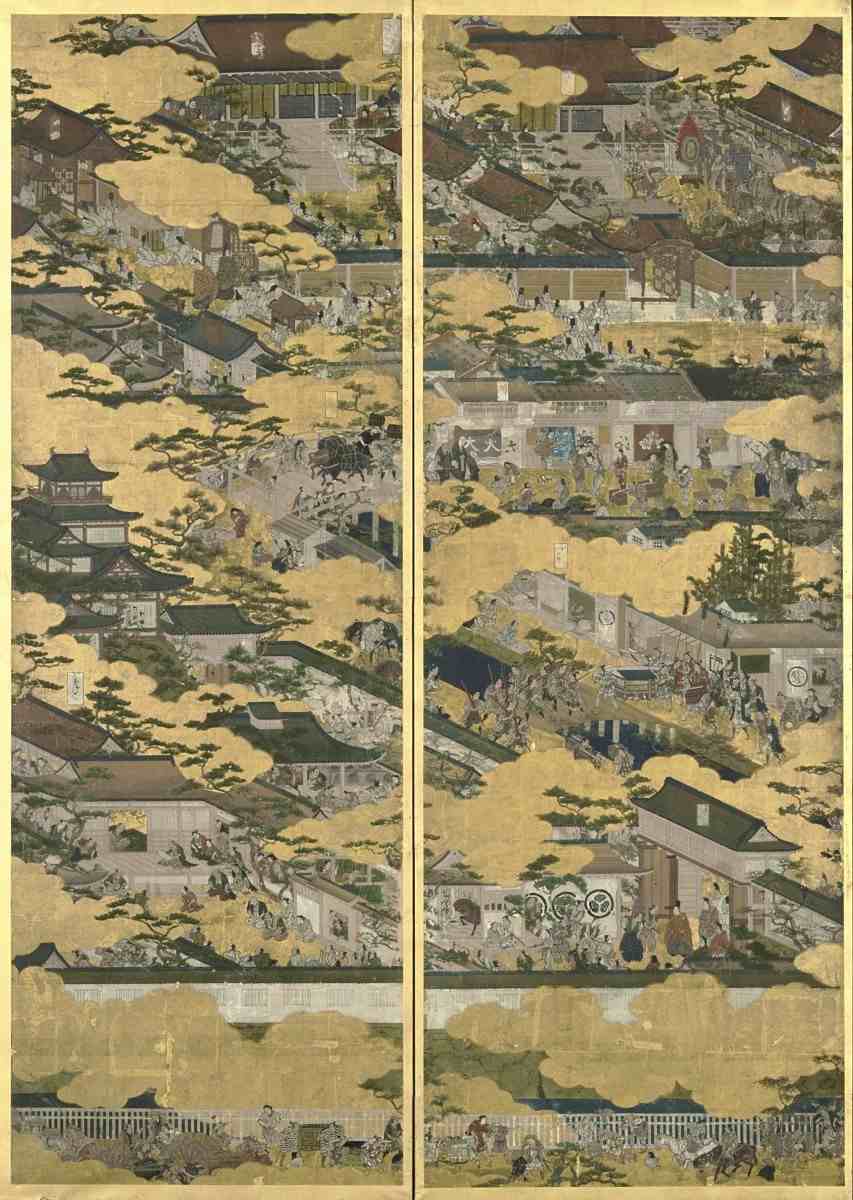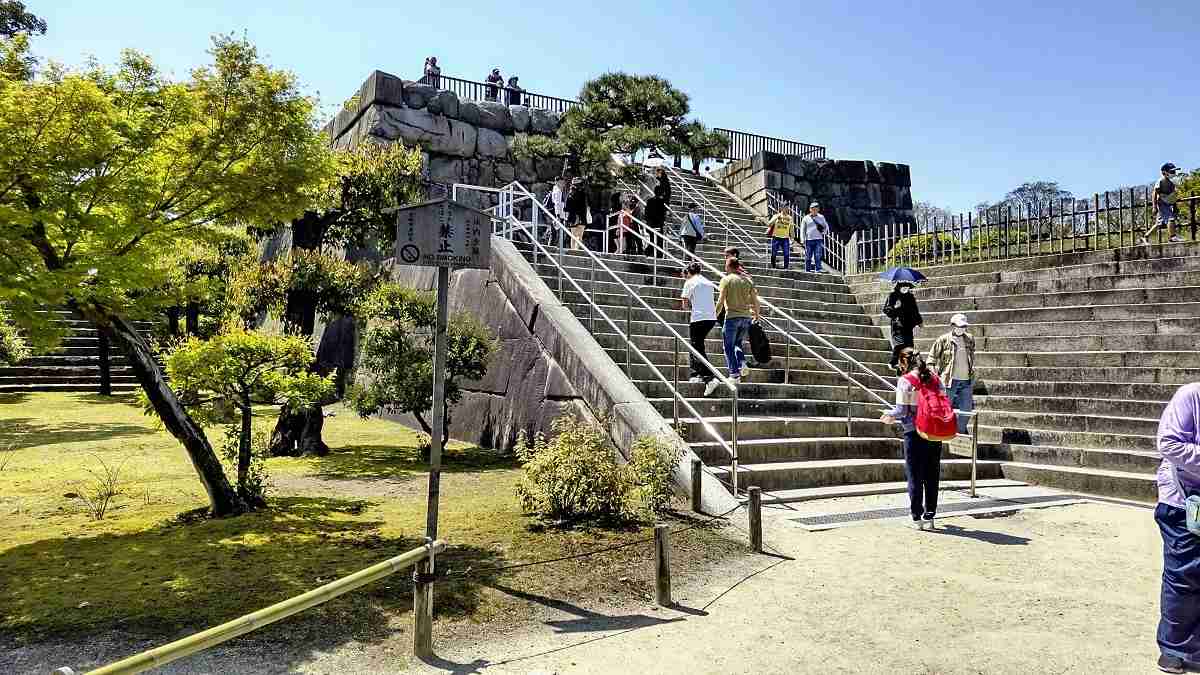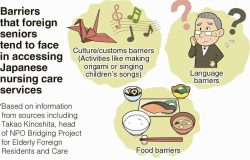Secrets of Kyoto / Nijo Castle ‘Moved’ to its Central Kyoto Location; In the Past, Shogun Preferences, Geology Shaped What Was Considered ‘Central’

Ninomaru Palace is a shoin-zukuri style residence built in the early Edo period. It consists of six buildings, including the kuroshoin, where the shogun met with feudal lords and other close associates.
11:40 JST, May 9, 2024
Some may think that Kyoto Imperial Palace, where emperors conducted political affairs for many years, is the center of Kyoto. But if that’s what you think, you should take another look at a map.
The Imperial Palace is actually off to the northeast of the city’s center.

The keep of Nijo Castle is painted on the far left of the Funaki version of the Rakuchu Rakugai-zu folding screen which depicts Kyoto and the area around it.
Instead, Nijo Castle is at the heart of the city. The castle was built as a residence for the Tokugawa shoguns during their Kyoto visits from Edo, the old name for Tokyo.
In medieval to early modern Japan, urban castles were used as bases for samurai to control the surrounding country.
Some examples include Edo Castle, which is now the Imperial Palace, in Edo; Osaka Castle in Osaka; Nagoya Castle in Nagoya; Fukuoka Castle in Fukuoka and so on.
On the other hand, there are no castles in Yokohama or Kobe, which grew up around trading ports in modern times.
Heiankyo, later called Kyoto, was built long ago when it was ruled by court nobles. Kyoto is a city with an exceptional historical background that now has a population of nearly 1.5 million.
The customs adopted by the court nobles of Heiankyo differed from those of the samurai in later periods.
For example, the saying goes, “Rulers face the south,” which explains why the emperor sits with his back to the north and faces south.
The idea is derived from the “Book of Changes,” an ancient Chinese Confucian text. An emperor, like the North Star, is not supposed to move, but rather face the south, where the sun shines.
The eastern side of Heiankyo was called “sakyo,” or “left of the capital,” and the western side was called “ukyo,” or “right of the capital.” This is because from the perspective of the emperor, who sits with his back to the north and faces south, the eastern side is left, and the western side is right. Quite the opposite of a map, which shows north at the top.
In Heiankyo, the Imperial Palace was located at the north end of the 84-meter-wide Suzaku-oji street, which formed the central north-south axis of the capital.
However, because the ukyo area to the west of Suzaku-oji street was a low marshy area, court nobles and commoners who lived there gradually moved eastward to the sakyo area, and then further east.
In the medieval and early modern periods, Kyoto comprised the sakyo eastern side of Heiankyo as well as the area extending east of it.
The Imperial Palace also moved east, to its present location.

The san-no-ma room in the Kuroshoin building at Nijo Castle
Tokugawa Ieyasu, the eventual victor of the wars of the late medieval period, based himself at Fushimi Castle on the southern outskirts of Kyoto.
It was at this castle that he received the title of shogun from the emperor’s envoy. However, the castle was far away — about 10 kilometers — from the Imperial Palace. As a result, he decided to construct another castle in the central district of Kyoto.
There was no room to build a new castle in what was then the center of Kyoto, so Nijo Castle was built in a position off to the west.
A map of Kyoto during the Edo period shows that the castle was located on the western edge of the city center, which was mostly fields.
In modern times, the fields on the western side have become part of the city. Roads that briefly disappeared were rebuilt as well. As a result, Nijo Castle is now in the center of Kyoto.
The castle initially had an intimidating five-story keep overlooking Kyoto.
Kyoto, like other cities, was a castle town where samurai held power.
In 1750, however, the castle keep was destroyed by a fire caused by a lightning strike. The tower was never rebuilt, partly because the Tokugawa shogunate’s rule was stable then.
Ninomaru Palace, the main building of Nijo Castle that remains today, was built in the shoin-zukuri style of samurai residences, and its graceful design seems to blend in with the city of Kyoto.


Top: The five-story keep of Nijo Castle was destroyed by lightning in 1750. Now only the stone walls of the foundation remain in Nakagyo Ward, Kyoto.
Bottom: The karamon gate features bright colors and luxurious and exquisite carvings, including of pine trees, bamboo, plum trees and cranes, which signify longevity.
"JN Specialities" POPULAR ARTICLE
-

The Japan News / Weekly Edition (12/12-12/18)
-

English-language Kabuki, Kyogen Entertain Audiences in Tokyo; Portland State University Professor Emeritus, Graduates Perform
-

Noodle Dining Shunsai / Rich Oyster Ramen to Savor at Odasaga; Experienced 68-year-old Owner Creates Numerous Ramen Varieties
-

The Japan News / Weekly Edition (12/5-12/11)
-

People Keep Loved Ones’ Ashes Close in Special Jewelry, Small Urns as Unique Way to Memorialize Them
JN ACCESS RANKING
-

Keidanren Chairman Yoshinobu Tsutsui Visits Kashiwazaki-Kariwa Nuclear Power Plant; Inspects New Emergency Safety System
-

Imports of Rare Earths from China Facing Delays, May Be Caused by Deterioration of Japan-China Relations
-

University of Tokyo Professor Discusses Japanese Economic Security in Interview Ahead of Forum
-

Japan Pulls out of Vietnam Nuclear Project, Complicating Hanoi’s Power Plans
-

Govt Aims to Expand NISA Program Lineup, Abolish Age Restriction

























